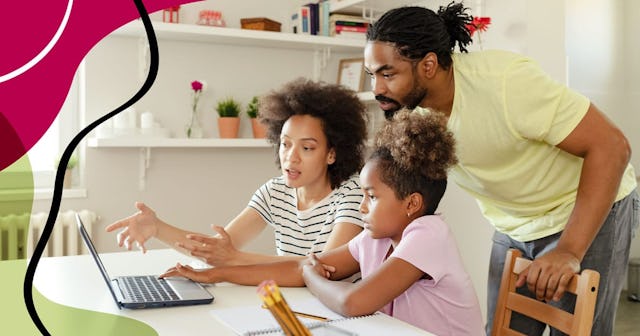7 Ways We Are Gearing Up For Another Round Of Distance-Learning

It’s inevitable, it seems, that we will all be headed back to distance learning at some point this fall or winter. Why? People are attending summer parties, crowding bars and restaurants, going on vacations, and not keeping their mask on. Can you hear me sighing? COVID-19 rates climb, hospitals are overburdened, and some people just keep on living their best life as if the world hasn’t gone to hell in a handbasket.
I’m a proactive person, and I think it’s smart that we collectively gear up for distance learning. Whether you’ve already opted for it or not based on your school district’s offerings, there are ways we can get prepared now for the very-possible future. Many of us learned our lessons (pun intended) in the spring when schools closed. E-learning is not easy, but by having a solid plan in place, perhaps it will go better the second time around. Here are ways I’m preparing for distance-learning now.
Set up a designated learning space.
Work to create a comfortable and minimalist learning space for your child. Do they prefer a desk, the kitchen table, or maybe a beanbag chair on the floor? Purchase any organizational necessities, such as folders and bins. Allow your child to personalize the space, making sure it’s both fun and functional, but don’t allow it to be cluttered. Does your child prefer to have quiet and privacy, or is an ideal space for them one that’s in a more public space? If you’re parenting multiple children, be sure to consider each of their needs and preferences.
Buy new devices, or inquire early at your child’s school.
We quickly learned our kids’ ancient iPads were not going to cut it when it came to distance-learning. We made it work, but I admit that it was anything but pleasant. When we finally started researching Chromebooks, they were sold out everywhere. We didn’t make the same mistake twice, purchasing a Chromebook this summer and giving it a trial run to make sure it would meet our child’s remote learning needs. Also, check on your internet service to see if you have the bandwidth to meet remote learning demands.
If a new device isn’t in your budget, check with your school district; most have loaner devices available for families who cannot get access to one on their own, but it may be first-come, first-serve, so contact them before the back-to-school rush.
Ask about your child’s IEP.
Some districts are re-visiting students’ IEPs (remember, those are Individual Education Programs created for students with special needs) and tailoring them for remote-learning. This is absolutely critical, because learning in a classroom with an in-person teacher and learning via a device with a remote teacher are not at all the same. Go over your child’s current IEP carefully, and begin creating a list of ideas on how each accommodation and goal can be met in the home environment with support from the school.
Create a schedule.
kate_sept2004/Getty
Routine is magical, because expectations bring a sense of stability, especially in this unstable situation. Routine also helps set a child up for success. You don’t have to be super-specific unless that’s what your child needs. Make sure your routine has a good balance of school work and breaks for exercise and food. We work chores into our daily routine, too, because they double as a break from learning as well as movement. Have a set wake time, time your child starts working, and even more importantly, a stopping point.
Schedule recess, even for older kids.
Make absolutely sure you build in gross movement (recess) breaks to ensure your child isn’t experiencing eyestrain while also maintaining a healthy body. Outdoor play is great for vitamin D3 exposure and a change of scenery, but if that’s not possible, there are other options. Your child can do a dance or yoga video, do a chore that involves movement (vacuuming, for example), or use any exercise gear you have. If you have limited space, good options include free weights, a mini-trampoline, and exercise bands. Another option is to go for a short walk together.
Encourage student-teacher communication.
You are not, I repeat, you are not your child’s teacher. You are certainly a support and a guide, but when opting (or being forced into) remote learning, it’s important that you empower your child to communicate with their teacher when they have struggles or questions. Additionally, you don’t want to give your child incorrect guidance. I certainly am not qualified to teach my sixth grader math, for example. I can certainly try to offer clarity, but the reality is I can’t always do so. If your child is younger, you can certainly communicate with the teacher on your child’s behalf, but include your kiddo when you’re composing an email.
Lower your expectations.
Parents will take the lead on remote learning. This means setting the tone. Parents are often encouraged to push their kids to the brink, but we need to remember that we’re all in the midst of an incredibly stressful situation. What’s more important than academic perfection and “honor roll” is our children’s physical, mental, and emotional health—as well as our own. We also need to extend grade to educators, many of whom are parents themselves. It’s okay to make like Elsa and “let it go”—whatever the ”it” is in each of our e-learning experiences.
Distance learning is challenging for us all, but it can be more successful with some proactive work. Even if you have elected for in-person learning at this time, there’s a strong likelihood that remote-learning is in your child’s near future. My type A self feels better knowing that we have a solid plan in place.
This article was originally published on